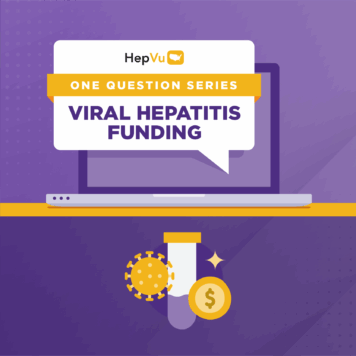Heather Bradley, Ph.D., is an Assistant Professor of Epidemiology at Georgia State University and serves as HepVu Project Director.
Ron Valdiserri, M.D., MPH, is Senior Research Associate and Distinguished Scholar, Johns Hopkins University, Bloomberg School of Public Health, Former Deputy Assistant Secretary for Health, Infectious Diseases, U.S. Department of Health and Human Services, and serves as HepVu Co-Chair.
Q: New data from the Centers for Disease Control and Prevention (CDC) reveal that although there is still a high burden of Hepatitis C infection among Baby Boomers, the largest increase in new infections is among individuals under 40 years old, particularly due to injection drug use. Are these two separate epidemics or are they interrelated?
In some ways, they are distinct epidemics. Broadly speaking, we are seeing that when young people are newly infected with Hepatitis C virus, it is often associated with injection drug use related to America’s ongoing opioid epidemic. That is not the case with Baby Boomers (those born between 1945 and 1965), most of whom have been chronically infected with Hepatitis C for decades. Baby Boomers were infected with Hepatitis C before the virus was identified, through injection drug use, blood transfusion, and, as recent studies suggest, medical practices that are no longer considered safe, such as reusing medical syringes (which occurred before the advent of disposable syringes). Prior to the discovery of Hepatitis C in 1992, blood supplies were not universally screened for Hepatitis C and, as a result, blood transfusions were a source of new infections. Outdated medical practices as well as battlefield conditions during World War II made previous generations, including Baby Boomers, much more likely to be exposed to Hepatitis C.
In recent years, though hundreds of thousands have been cured of Hepatitis C with highly effective drugs – “direct acting agents,” or DAAs – even more may not know they are infected. CDC estimates that half of those infected with Hepatitis C are undiagnosed. This fact, coupled with recent increases in new Hepatitis C infections among younger individuals, much of it correlated with injection drug use, makes eliminating the Hepatitis C epidemic all the more challenging.
Q: In addition to data on Hepatitis C, HepVu added three maps that look at specific opioid epidemic indicators. What insights can we draw from these maps and how can those insights help us understand the syndemic between opioids and hepatitis?
HepVu currently visualizes three state-level opioid indicators. Opioid prescription rate shows retail opioid prescriptions dispensed per 100 persons in each state. Narcotic overdose mortality rate shows the number of drug overdose-related deaths per 100,000 persons in each state. Pain relievers misuse prevalence shows the percentage of people misusing prescription pain relievers in each state.
One of the important trends that these indicators highlight, especially opioid prescription and narcotic overdose mortality rates, is the opioid crisis’ impact on the U.S. Appalachian region. The region continues to be hardest hit by the opioid epidemic and, consequently, injection drug use – which is where Hepatitis C comes into the picture, given that the virus is a blood-borne infection. It’s so important that we continue to monitor the connection between the opioid and Hepatitis C epidemics in order to inform public health action and raise greater awareness about the infectious disease consequences of the opioid epidemic.
Q: The new data on HepVu reveal that there appears to be convergence in some states, particularly in Appalachia, that are highly impacted by the opioid epidemic and states that are experiencing a high rate of new Hepatitis C infections. How is the opioid epidemic changing the way we look at Hepatitis C?
We know that new cases of Hepatitis B, C, and HIV are often-overlooked consequences of the opioid epidemic, since all three viruses are transmitted through infected blood among persons who inject drugs, and who do not have access to sterile injection equipment and other needed substance use treatment services. Ongoing study and experience have made it clear that some blood-borne diseases have become more prevalent as opioids (and related injection drug use) have become more and more of an issue. Three Appalachian states – Kentucky, West Virginia, and Tennessee – are among the ten states hardest hit by Hepatitis C, according to our new analysis. It is clear that Hepatitis C rates are higher in geographic areas that are highly affected by the opioid epidemic.
Q: The Western U.S. continues to have the highest rates of Hepatitis C infection. Why is this?
Understanding the high rates of Hepatitis C in the West continue to be an important research question. Ten of the 13 states in the Western region had Hepatitis C prevalence above the national average. It’s even more puzzling because other researchers have also noted this disparity, yet there are no publicly available data explaining the cause behind it. The high rates are reflective of the prevalence in the National Health and Nutrition Examination Survey (NHANES), but these kinds of data stop short of telling us the “why” behind the rates. Further research and data analysis will be needed to provide a full picture of what’s driving such high rates in this particular region.
Q: HepVu previously mapped 2010 Hepatitis C data. Why is it so difficult to acquire updated data and why is it so important to have reliable, current data on Hepatitis C?
As detailed in the National Viral Hepatitis Action Plan 2017-2020, a lack of data on Hepatitis C continues to be a challenge for public health experts, researchers, policymakers, and community advocates. Having comprehensive data about the Hepatitis C epidemic – and where it is hitting communities the hardest – can aid public health response in driving prevention and treatment strategies. HepVu seeks to help address the lack of data by providing standardized state-level estimates of Hepatitis C mortality (2016) and prevalence, which have just been updated from 2010 to 2013-2016.
Though Hepatitis C is a leading cause of liver-related death in the U.S., overall, surveillance remains limited not just for Hepatitis C but for all types of hepatitis. As Dr. James Curran famously said about HIV surveillance, it is “the conscience of the epidemic.” Surveillance helps us understand what is happening across the country and can serve as a guidepost to determine how resources, prevention, and treatment are best allocated. Surveillance can also measure our successes. Hepatitis C is a curable disease, and many communities are talking about elimination. Without a robust surveillance system for Hepatitis C, we cannot benchmark our work as a nation.
Q: Hepatitis C is a curable disease. What more needs to be done to prevent new infections and ultimately end the epidemic?
First, continuing to drive efforts to collect comprehensive data about Hepatitis C can help inform public health response strategies and decision-making—as well as raise awareness among the general public about the infectious disease consequences of America’s ongoing opioid epidemic. It is also critical to intensify prevention efforts, particularly as injection drug use as a result of the opioid epidemic drives new Hepatitis C infections. Accessible syringe service programs and adequate substance use treatment services would greatly aid such prevention strategies. Finally, routine screening for Hepatitis C would make more people aware of their status and enable those who are infected to receive treatment early, and to be cured of Hepatitis C.



